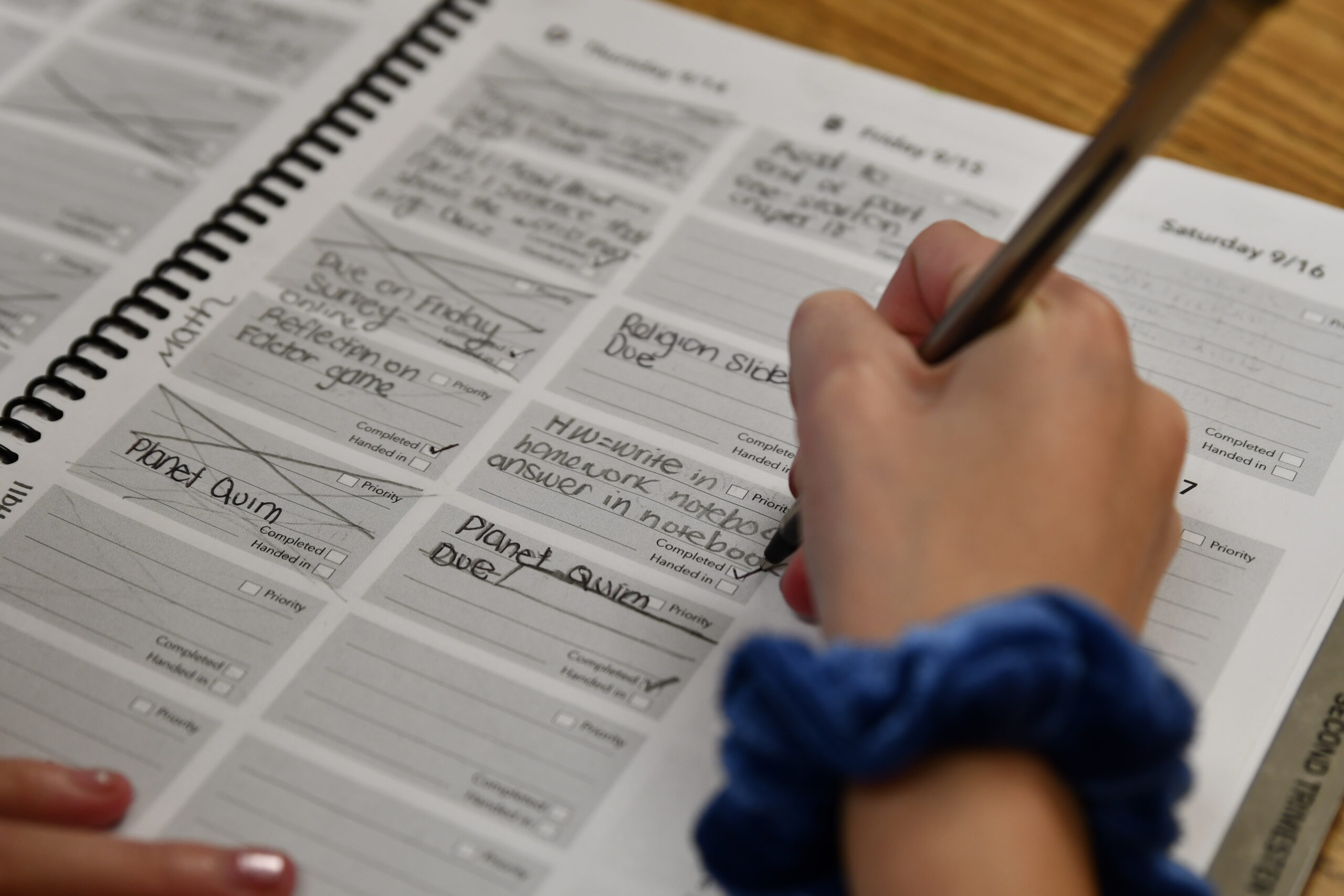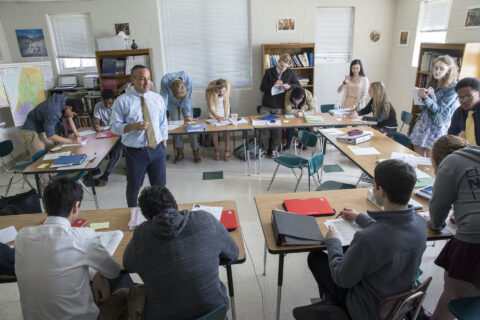On a very basic level, executive functioning is a set of mental skills that helps individuals complete tasks and effectively manage their time. Many articles refer to executive functioning as the CEO of the brain. The more we at St. Andrew’s learned about Mind, Brain, and Education Science, the more we wondered, “Are there links among handwriting, memory, executive functioning, and helping students make sure all their assignments are completed and turned in?”
Executive functioning is a set of skills that can be learned through careful, systematic instruction. Like muscles, these skills need to be flexed or practiced in order to be strengthened.
The supporting role planners play in executive functioning
For students, one of the greatest demands on their executive functioning, and thus the higher order thinking part of the brain associated with it, the prefrontal cortex, is how they plan each day to meet the various demands on their time: school, clubs, sports, music lessons, social life, and, importantly, sleep. Planners help students learn how to identify priorities, outline their short and long-term goals, and space out larger assignments into more manageable chunks.(1)
Most of us, who were probably born before 1990, used to plan a day, week, month, or year using traditional paper planners. However, technology, including online calendars and virtual planners, now offers choice in how we “write-down” what we have to do. The question, then, for each individual student is, “Which planner type, paper or digital, is best for me as a learner?”
Paper versus digital planners
Research tells us that when you write something down, you are more likely to remember it. (2) Why is this? Researchers think it is because when we write something down, we are thinking harder to make more deliberate decisions about what is important. There appears to be something about slowing down and making a judicious decision about what to write that helps things stick better in long-term memory. Research also suggests that reading traditional paper text has benefits over electronic books. (3)
While many students have turned to electronic tools to plan their lives, the research behind writing things down remains compelling. It is our hypothesis that the act of physically writing something may be the best way for most students (4) both to remember their assignments and improve their executive functioning skills.
With the increase in online Learning Management Systems (at St. Andrew’s we currently use Schoology), the practice of writing down assignments has decreased. Students are no longer writing down their assignments in paper planners but instead are relying on digital mechanisms where the teacher is responsible for writing down the assignment. By doing this for the students, students are no longer actively engaged in the homework planning process, which may have two effects. First, they may not be as successful or efficient at planning their homework. Second, they are losing opportunities to increase their executive functioning skills.
Writing enhances memory
Listening and writing activate the brain so that memory is enhanced; therefore, when students take pen to paper and write down their homework when it’s announced in class or written on the board, they are far more likely to remember it. It is also possible that physically writing down what needs to be completed each night might be a stress reliever because it allows the students to see exactly what needs to be done and when. Writing things down also frees up working memory, which is both limited and in high demand, which helps enable long-term planning and higher order thinking.
Effective use of paper planners may improve executive functioning skills by allowing kids to keep track of their homework and long-term projects, manage their time, chunk long-term assignments into smaller more manageable segments, gather the needed materials for homework and projects, set short and long-term goals and self-monitor progress, prioritize, and reflect on previous actions and strategies.
Research suggests that students interact with paper books and electronic books differently, (5) and we believe that the executive functioning skills we just mentioned might be more effectively practiced when students are interacting with the information in paper form. In part this is because the paper book forces them to interact with and manipulate the information, whereas in a digital format they are likely to be just consuming it, probably in a non-linear fashion.
The SAES student planner
In 2015, in a partnership between the Educational Center at St Andrew’s and the CTTL, we sought to apply research in executive functioning to design a new student planner.
In the SAES planner:
- Students can see the weekly overview along with tabs for each trimester. Time management, which can be a challenge for even the most successful student, is all about planning and controlling the amount of time spent on activities. By having a weekly view along with grading period tabs, students are able to keep track of their assignments, make a plan for executing those assignments, and keep track of their time. This helps students see the “big picture” and better control and plan their time.
- Students are able to prioritize their assignments in relation to when classes meet and when long-term projects may be due by being provided with the type of day on the weekly overview (and with each daily schedule in the back of the planner).
- Students are also able to look at each month “at a glance” and have a preview of the next week. This helps develop long-term planning skills and helps students manage their time.
- Students can physically check off the boxes “completed” and “turned in” for each subject that the school day demands. Feedback from students suggests that the active process of checking off completed work creates a greater sense of accomplishment. Feedback from teachers and students told us that “completing” and “turning in” are two very distinct episodes, and identifying them as such helps ensure that both happen.
- Students can number the order in which assignments and other tasks will be completed. This helps their time planning and prioritization skills.
- Students can use the “undone from previous week” box on the left side of the page and the “weekend” boxes on the right side to see and organize their week, which allows them to chunk out their assignments into more manageable portions.
- Students are set up for success with a “materials needed” box for each class that helps them arrive to school, and each class, ready to learn.
Every middle school and ninth grade student begins each new school year with the St. Andrew’s planner. In the first three years of the planner’s evolution, we have observed an increase in the number of students regularly using the St. Andrew’s paper planner as their go-to means of organizing their work. Emily Todd ’17 shared her experience with the St. Andrew’s paper planner:
It was by far one of the most effective tools I used daily throughout my time in high school. The planner became more critical to use as classes got harder. I went from simply writing assignments in the boxes to color coding everything and writing due dates to projects weeks in advance. There is so much going on in high school among academics, athletics, and social life that it is essential to use the planner in order to keep track of everything in one place. The St. Andrew’s planner is different because it adapts every year to incorporate academic schedule changes and to fit the needs of the student body.
The planner is being used just as much by students who have strong executive functioning skills as those who currently do not, which is interesting, and we see as a sign that we did well in including the features we did. As pointed out in “We All Need Executive Functions,” (6) every individual has executive functioning strengths and challenges.
Executive functioning is a crucial set of skills from which we can all benefit and improve. Developing a St. Andrew’s, home-grown resource that aligns with research on executive functioning and memory that helps students organize and prioritize their work ultimately empowers students to become more efficient, confident, and independent learners who are in more control of attaining their goals.
A good planner is good for everyone.
Samantha Speier is the Director of the Education Center and a Middle School Academic Dean at St. Andrew’s.
This article was originally published in Volume 3 of “Think Differently and Deeply” (2018).
Citations
- Peter C. Brown, Henry L. Roediger III, and Mark A. McDaniel. Make It Stick: The Science of Successful Learning (Cambridge, Massachusetts: Belknap Press, 2014).
- Robinson Meyer. “To Remember a Lecture Better, Take Notes by Hand.” The Atlantic, May 1, 2014. (https://www.theatlantic.com/technology/archive/2014/05/to-remember-a-lecture-better-take-notes-by-hand/361478/).
- “Electronic Textbooks: What’s the Rush?” Daniel Willingham–Science & Education. Accessed January 31, 2018. (http://www.danielwillingham.com/1/post/2012/04/no-title.html).
- We say ‘most students’ in recognition that for some students, for a variety of reasons, the reverse may be true – but all students need to work at finding the strategy that works best for them.
- Department of Psychology, James Madison University. E-textbooks Effectiveness Studied (https://www.jmu.edu/news/2012/03/02-students-research-challenges-e-readers-claim.shtml).
- Ian Kelleher, “We All Need Executive Functions,” Think Differently and Deeply (Vol. 2), 2015, 36-37.




